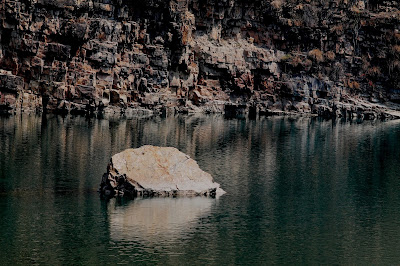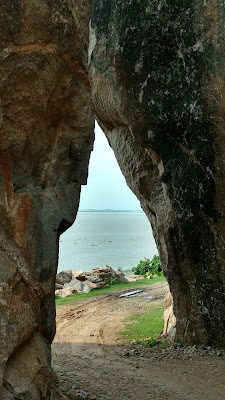A neonatologist M, a writing mentor K, an on-the-verge-of-published-writer-now-published R, a trained singer cum linguist Kay, an ace blogger Mr P and an anxious traveler vacillating between motion sickness and absorbing the landscape Me.
Apart from the common destination of a writer’s retreat in the Himalayas (
sounds exotic? It was!), we had one tendency in common. It was the penchant
for bursting into a song in all possible scales and tune trajectory with any
uttered word. The second common factor though was a nightmare, Mr P hadn’t bargained for as if being the lone
representative of his kind wasn’t bad enough.
The six of us began our drive from Haridwar to Guniyala, a sleepy hamlet in Pokhari tehsil of Uttarakhand. It was pitch dark at five in the morning as the vehicle left Haridwar and moved through the Rajaji National Park. Five heads lolled from side to side trying to catch up on remaining sleep before the sun peeped up over the rolling peaks. But apart from the driver Karan, K wouldn’t retreat into slumber. She had been on this route umpteen times to know every bend, every bush, every tree en-route. It was a wonder she did not stop every now and then to say hello to the landscape and all the mobile and immobile denizens of the countryside.
The six of us began our drive from Haridwar to Guniyala, a sleepy hamlet in Pokhari tehsil of Uttarakhand. It was pitch dark at five in the morning as the vehicle left Haridwar and moved through the Rajaji National Park. Five heads lolled from side to side trying to catch up on remaining sleep before the sun peeped up over the rolling peaks. But apart from the driver Karan, K wouldn’t retreat into slumber. She had been on this route umpteen times to know every bend, every bush, every tree en-route. It was a wonder she did not stop every now and then to say hello to the landscape and all the mobile and immobile denizens of the countryside.
“People! You have to be alert now because we are going to
come across that first view of the river Ganga as we begin our climb. It is one of the most ...” she goes on sitting at the edge of her seat straining against window pane.
No response from the other five sleeping members. Me, I
was having a hard time holding back the contorting stomach that threatened to
spill out and spread embarrassment.
“The best thing I like about this journey is how you get
to see the Ganga in all her moods..” K was at it, exhorting, cajoling and reprimanding us in turns for the lack of enthusiasm.
All she received was appropriate interjections of polite grunts and sighs . And then I couldn’t take it
anymore.
“Please stop the car…”
I just about
managed to bend over the edge of the road. By the time we reach the first pit
stop we had stopped once more, no thanks
to me. Furniture were still being dusted, some shutters were yet to be heaved
up. Worried at how was I to reach Guniyala without inviting the looks of disdain from my
co passengers, I joined the others in strolling over to the other side of the road.
That is one vision guaranteed to infuse energy and well being in any traveler! We drank in the rushing water of the river running along in the morning silence and bird songs blowing in the breeze! We waited and watched the birds dip and glide over the water, perch on the branches on the banks. Waiting for our breakfast to arrive, fiery red specks of palash on the corrugated roof of the shop across the road caught my eye. Yesterday’s flowers had given way to new blossoms marking the beginning of a new cycle. A change with every turn of the wheel.
 |
| First Pit Stop And First Glimpse |
That is one vision guaranteed to infuse energy and well being in any traveler! We drank in the rushing water of the river running along in the morning silence and bird songs blowing in the breeze! We waited and watched the birds dip and glide over the water, perch on the branches on the banks. Waiting for our breakfast to arrive, fiery red specks of palash on the corrugated roof of the shop across the road caught my eye. Yesterday’s flowers had given way to new blossoms marking the beginning of a new cycle. A change with every turn of the wheel.
When we took off again, sunshine had wriggled its way into our vehicle. Conversations picked up, eyes moved out to drink in the
passing landscapes and I was strapped in as the co-driver. Mentally I had
picked up some dust from the front CEAT tyres and touched it to my
forehead. A trick I was taught long ago by a kind driver on our way
to Shillong. Just another one of those rituals they believed in, like reversing
if a cat crosses the road or saluting the steering wheel before switching on
the headlights when dusk creeps in. He
believed the dust from the wheel stopped the motion sickness. By now I was desperate
to try out anything.
A quick stop at Teen Dhara, just short enough to gulp
down a glass of its famed masala nimbu paani, is a ritual any traveller on this road vouches for. Just like the sheds selling Maggi in most mountainous trails. Somehow Maggi never tastes the same in the plains. We were making steady progress with Karan's consistent driving skills. He was not in a hurry to reach our destination which
gave us ample relaxed nerves to enjoy the scenario with our hearts and stomachs very much
in their rightful places. Quiet in contrast to some others zipping on the curves. We were secured enough to belt out one song after the other. Driving is an art
really.There is to be just the right amount of pressure on the brakes anticipating
a break in the speed, the smooth shift of gears, the build up of the speed and
sticking to the permissible limit. Ask me.The slightest inconsistency has me throwing up especially
the clutch- brake dreadful duo, lurching the vehicle in jerks and spurts. A smooth drive is when the passenger's mind takes off from the road and spreads itself in the surroundings, conscious of thoughts rising up one after the other.
 |
| Devprayag |
We stopped once again. This time to peer down at Devprayag, the first
of the Panch Prayag in Uttarakhand. A temple stood at the confluence and its steps
led down to the merging waters of the Alaknanda and Bhagirathi rivers. Watching
the two Himalayan Bulbul perch on a frail branch, I realized there is something
calming about gushing water of a river. The tiredness, the anxiety seemed to
ebb away and join the waters down below and the river bundled them up before carrying them away from me. This break proved to be wise in more ways than
one. K suggested I take the wheel and give Karan a break much to the
consternation of the others including Karan although he kept the perfect poker face. We still had a long way to go, another hundred kilometers or so, and I did not seem reliable exactly. On hilly terrains the time can stretch
way beyond what is accepted in the plains including the hazards of stopping at
every picturesque bend.
 |
| Himalayan Bulbul And Alaknanda |
The wheels so far had filled me with dread as to how was
I to survive the trip. It had me wondering about the return trip so much at the
end of three days, that I had a good mind to rent a hut there on the hill top forever. But the wheels under my control now filled me confidence, letting me enjoy the show. I chipped in with my share of the tuneless singing along with the more tuneful ones. That’s when the thought struck me! Here I was, away
from my family, away from all the domestic issues, on a road trip with acquaintances turning into friends and travelling without any
roles attached. With every turn of the wheel was a revelation waiting to be explored. Each of us is born tough, we only had to rediscover this mantra.
 |
| Layers And The Flow |
Gradulally the road liberated me and the CEAT tyres turned the
way I steered. A white blinding patch caught our attention and we decided to
stop. Reaching the destination was no longer a priority. We did not want to
miss anything the journey offered. We were collecting gems for posterity. It
was a stretch of river beach, pristine in its white sands. From the water rose a few boulders, sunning themselves in the blazing sunshine, displaying
with pride each layer it had accumulated over the ages, holding its own even in the flowing
water. I could have sat there for hours together, just watching the river and
the rocks.
 |
| Lofty Himalayan Peaks From Guniyala |
The songs came in wild abandon from behind. I was a happy
traveler now but also focusing on the road. With my liberation from misery I
also had a responsibility of ferrying my friends in safety. Karan, much
experienced on this route, in the co driver’s seat was stable and alert.
Whenever the traffic increased near little towns I followed his calm gestures to
avoid tricky spots. How the weather had changed since morning in this moving vehicle! By the time we wound our way up to Guniyala, the mountains changed for me. It opened its arms and stretched out to reveal the lofty peaks of Badrinath and Kedarnath. It revealed a rhododendron forest, a grand show of thundershower and a spectacular burst of the rainbow! That is how I have remembered this trip ever since - the rainbow at the end of the road.
‘I’m chronicling my road trip adventure for CEAT Tyres in association with BlogAdda.’
‘I’m chronicling my road trip adventure for CEAT Tyres in association with BlogAdda.’


























